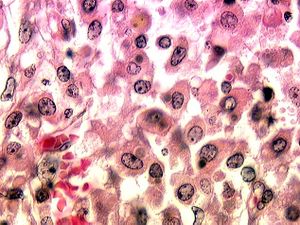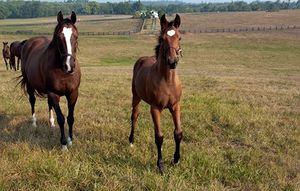Rhodococcus equi: Difference between revisions
No edit summary |
No edit summary |
||
| Line 11: | Line 11: | ||
==Description and Significance== | ==Description and Significance== | ||
''Rhodococcus equi'', originally discovered in horses by Magnusson, is a pathogen that is known to be able to affect animals and humans [[#References | [4]]]. ''R. equi'' is a gram-positive coccobacillus that has the ability of producing a red pigment. It is a non-motile bacteria from the phylum Actinobacteria that is also aerobic and non-sporulating [[#References | [1]]]. Up until 1983, this bacteria was mostly found to infect animals such as horses and foals [[#References | [1]]]. Now there are more cases being seen in humans, especially those who are immunocompromised such as patients with AIDS [[#References | [4]]]. ''R. equi'' generally leads to subacute or chronic bronchopneumonia which can lead to mortality, especially if not treated in the early stages [[#References | [3]]][[#References | [1]]]. | ''Rhodococcus equi'', originally discovered in horses by Magnusson, is a pathogen that is known to be able to affect animals and humans [[#References | [4]]]. ''R. equi'' is a gram-positive coccobacillus that has the ability of producing a red pigment. It is a non-motile bacteria from the phylum Actinobacteria that is also aerobic and non-sporulating [[#References | [1]]]. ''R. equi'' is able to utilize carbon efficiently and is therefore important to the recycling of carbon in the soil [[#References | [4]]]. Up until 1983, this bacteria was mostly found to infect animals such as horses and foals [[#References | [1]]]. Now there are more cases being seen in humans, especially those who are immunocompromised such as patients with AIDS [[#References | [4]]]. ''R. equi'' generally leads to subacute or chronic bronchopneumonia which can lead to mortality, especially if not treated in the early stages [[#References | [3]]][[#References | [1]]]. | ||
==Structure, Metabolism, and Life Cycle== | ==Structure, Metabolism, and Life Cycle== | ||
Revision as of 01:27, 22 July 2013
Classification
Bacteria/Actinobacteria/Actinobacteria; Actinobacteridae; Actinomycetales; Corynebacterineae; Nocardiaceae
Genus Species
Rhodococcus; Rhodococcus equi

Description and Significance
Rhodococcus equi, originally discovered in horses by Magnusson, is a pathogen that is known to be able to affect animals and humans [4]. R. equi is a gram-positive coccobacillus that has the ability of producing a red pigment. It is a non-motile bacteria from the phylum Actinobacteria that is also aerobic and non-sporulating [1]. R. equi is able to utilize carbon efficiently and is therefore important to the recycling of carbon in the soil [4]. Up until 1983, this bacteria was mostly found to infect animals such as horses and foals [1]. Now there are more cases being seen in humans, especially those who are immunocompromised such as patients with AIDS [4]. R. equi generally leads to subacute or chronic bronchopneumonia which can lead to mortality, especially if not treated in the early stages [3] [1].
Structure, Metabolism, and Life Cycle
Interesting features of its structure; how it gains energy (how it replicates, if virus); what important molecules it produces (if any), does it have an interesting life cycle?
Ecology and Pathogenesis
Natural habitat (soil, water, commensal of humans or animals?)
If relevant, how does this organism cause disease? Human, animal, or plant hosts? Important virulence factors, as well as patient symptoms.
References
[1] Kedlaya, Indira. 2013. "Rhodococcus equi". Medscape Reference: Drugs, Diseases and Pathogens. http://emedicine.medscape.com/article/235466-overview
[2] Kulich, Scott M., Pasculle, William A. 1998. "Final Diagnosis--Pneumonia, Hilar Lymphadenitis and Sepsis Secondary to Rhodococcus equi." UPMC Department of Pathology. http://path.upmc.edu/cases/case146/dx.html
[3] Meijer, W.G., Prescott, John F. 2004. "Rhodococcus equi". Veterinary Research-A Journal on Animal Infection and Epidemiology (35): 383-396. http://www.vetres-archive.org/file/Vet.Res._0928-4249_2004_35_4/Vet.Res._0928-4249_2004_35_4_ART0002.pdf
[4] Prescott, John F. 1991. "Rhodococcus Equi: an Animal and Human Pathogen." Clinical Microbiology Reviews. 4 (1): 20-34. http://www.ncbi.nlm.nih.gov/pmc/articles/PMC358176/pdf/cmr00042-0036.pdf
Author
Page authored by Mattie Hogg, student of Mandy Brosnahan, Instructor at the University of Minnesota-Twin Cities, MICB 3301/3303: Biology of Microorganisms.

